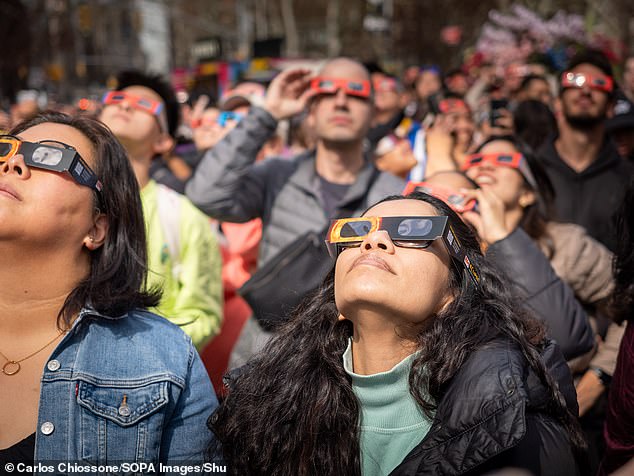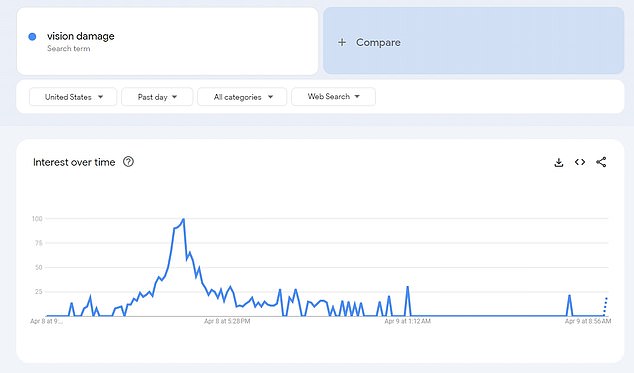Woman claims she went partially blind after watching solar eclipse for just 10 seconds without wearing goggles: ‘I couldn’t read’
A young woman has described her struggle with reduced vision and difficulty reading for six years after staring directly into the 2017 solar eclipse.
The young woman, Bridget Kyeremateng, 29, said she covered one eye and watched the eclipse through the other eye for about 10 to 15 seconds without wearing goggles.
When she woke up and looked at her phone, she noticed a gaping blind spot in her left eye, making it impossible to read every other word on her phone and recognize road signs.
A visit to an optometrist confirmed that she had irreversibly damaged her eyes, leading to migraines, blurred and distorted vision and white dots in her left vision line.
Staring at the sun every day is risky because it can burn the retina and cause permanent damage to vision. While some may believe it is less risky to look at an eclipsed sun, optometrists have still warned that the sun’s rays emerging from around the moon’s circumference can be just as dangerous.
Bridget Kyeremateng, 29, warned fellow eclipse watchers not to look at the sun as she did during the last solar eclipse six years ago, which left her with a burned retina and irreversible facial damage

Eclipse watchers were told to wear special glasses approved by the International Organization for Standardization (ISO), which are about 100 times darker than normal sunglasses.
The damage caused by staring at the eclipse may not be immediately apparent. Because there are no pain receptors at the back of the eyes, a stargazer may not register the damage done to their vision for hours.
In Ms Kyeremateng’s case, it was her noticed something was wrong the next morning.
She opened her phone when she woke up to find that all she could do was read every other word on the screen, and chalked it up to still being tired and dizzy.
But after walking around her house and waking up feeling better, the problem persisted.
‘There was a kind of blind spot with every other word I read… I couldn’t see things. And I said, “Oh my God.”
“I started driving to the ophthalmologist and couldn’t see the signs. This all happened in the space of 10 seconds; I looked at the sun for only 10 seconds.’
Once retinal tissue is destroyed, it cannot regenerate, so the damage suffered by the Brooklyn resident and likely thousands of other Americans who viewed the eclipse directly is irreversible.

Google searches for “vision damage” spiked yesterday afternoon during and after the solar eclipse, indicating that many people woke up Tuesday morning with some eye strain
The lure of viewing the heavenly miracle in 2017 left an unknown number of Americans with impaired vision the next day.
About 100 individuals in the U.S. and Canada presented to eye care professionals after the August 21, 2017 solar eclipse, complaining of eclipse-related retinal damage, according to an informal survey for the American Astronomical Society.
Google searches for “injured eyes” and “vision damage” peaked Monday afternoon, just after many Americans noticed this brief miracle.
Bright sunlight can damage the macula, the center of the retina that allows us to see the road while driving, read text and recognize faces.
Peripheral vision will probably be good, but the damage affects the central vision system.
Dr. Vicki Chan, a Los Angeles ophthalmologist, said, “Just as a magnifying lens pointed at the sun can burn holes in paper, the lens in your eye can focus sunlight to burn holes in your retina.”
Ms Kyeremateng said she has adapted to the permanent change in her vision, telling her thousands of followers that she still suffers from headaches on the left side of her face as her left eye has to work harder to keep up with the right.
Doctors told her she has slow 20/20 vision, meaning she can still see objects at a distance of 20 feet as clearly as an average person, but her brain takes longer to process what she sees or reads .
The blind spot in her vision remains, although she can be seen wearing prescription glasses and sunglasses when she goes outside.
She said the problem affected her daily life in the first six months after watching the eclipse, but added: ‘My eyes know what to do now and I wear prescription sunglasses.’
